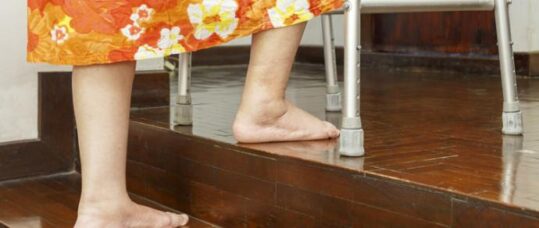Key learning points
- Older people should be routinely asked about falls when they come into contact with a nurse
- Older people who have fallen, or are at risk of falling, should be offered a multifactorial falls assessment and an individualised intervention
- Strength and balance exercise is one of the most important falls prevention strategies and should be offered to everyone who has fallen or is at risk of falling
Falls are hugely common in the older population, affecting one in three people over the age of 65 years and half of those aged over 80 years.1 Unfortunately, one quarter of these will suffer a serious injury requiring hospitalisation, but even a single non-injurious fall can increase the likelihood of long-term care, activity restriction, fear of falling, lack of confidence and social isolation.2 Fortunately, falls and falls-related injuries can be prevented, even by simple measures.
NICE has both a clinical guideline (updated in 2013) and a quality standard (updated 2017) for falls in older people.3 A summary of the key points in these documents is provided in table 1.
| Table 1 NICE guidelines and standards for falls in older people | |
|---|---|
| Falls in older people – quality standard 86 | Falls in older people: assessing risk and prevention – clinical guideline 161 |
| During routine appointments, ask older people about falls
Offer a multifactorial assessment and intervention to those who are at risk of falling or have presented following a fall Offer strength and balance training to those with recurrent falls |
Multifactorial risk assessment should examine:
Multifactorial intervention should:
|
Identifying older people at risk of falls
The single greatest risk factor for falling is a previous fall in the past 12 months.4 For this reason, all older people who either report a fall, or present with a fall, should be offered an assessment and intervention. However, as 30% of older people who have fallen in the last three months are unable to recall it, relying on patient-reported falls will miss a large proportion of high-risk individuals.5 Some older people are afraid to admit that they have fallen. This may be out of a fear of appearing frail or of being moved into a residential home.
Primary prevention, using the primary care record to identify people as high risk and offering them an assessment and intervention, does not reduce falls and is not cost effective.6,7 However, both NICE and the joint British and American Geriatrics Societies recommend that older people are routinely asked about falls or mobility problems to identify those most at risk.8 There are risk assessment tools available,9,10 but many require equipment, space and time. It may be more practical to simply observe patients walking in their home, or between the waiting room and the consultation room. If there is a gait or balance abnormality, or if the patient reports subjective abnormalities, they should be offered a falls assessment.
The multifactorial assessment
The principle components of the falls assessment are in table 1 above. There are few recommendations on how to specifically assess each of these, so the tools that are most appropriate to your population and service should be used. A detailed falls history is useful to identify specific problems, such as dizziness, home hazards or balance problems.
The multifactorial intervention
Strength and balance training
Exercise is one of the most important interventions and should be offered to everyone at risk of falls. However, not all forms of exercise are effective at reducing falls. For example, walking is not sufficient to prevent falls and Tai Chi is only effective for those who are at low risk.11 The most effective form of exercise is multi-component, addressing both strength and balance.
The most commonly used regimes are the Otago and the FAME programmes.12 They can be delivered in an individual’s home, or in
a group setting.
Home hazards
Ideally these should be assessed by an occupational therapist (OT), as there is evidence to show that this is more effective than a non-OT intervention.13 However, there are simple steps that can be recommended to all older people:
- Remove or tape down rug edges.
- Clear clutter from walkways and stairs.
- Ensure adequate lighting throughout the home.
- Position cables out of harm’s way.
- Remove door thresholds or make them more visible.
- Wear a pendant/watch alarm, or carry a mobile phone.
- Wear sensible footwear and maintain foot health.
Vision
Encourage older people to visit their optician every year and report falls to their optometrist. In general it is recommended that people do not use bi- or varifocal lenses if they are at risk of falls. Offer advice on how to keep eyes healthy, such as avoiding smoking, protecting eyes from the sun, eating brightly coloured fruit and vegetables, controlling diabetes and hypertension.
Medication
There is a lack of evidence on medications that should be stopped to prevent falls. In general, it is psychiatric medications that are most associated with falling. These include sedatives, antipsychotics and antidepressants.15 As with all medication decisions a risk/benefit discussion must be had with the individual.16 Cardiovascular medications, such as antihypertensives, are associated with falls, but there is no evidence that stopping them will reduce falls.
Falls are the most common reason that people with atrial fibrillation are not offered anticoagulation medication.17 However, one study found that an individual would need to fall 295 times per year for the risk of haemorrhage to outweigh the benefit of stroke prevention.18 Discuss the risks and benefits with the patient.
Bisphosphonates may be considered for those at risk of fracture. NICE recommends assessing the risk of fracture in all people with a history of falls using FRAX or QFracture.19
Underlying medical disorders
A 12-lead ECG and a lying and standing blood pressure should be checked as part of a multifactorial falls assessment. Cardiovascular disorders such as orthostatic hypotension, arrhythmias, carotid sinus syndrome and vasovagal syncope can all present as falls rather than as syncope in older people. When this is the case, individuals tend to experience dizziness, describe falling for no obvious reason or suffer facial and head injuries. These causes should also be considered for unexplained falls, or recurrent injurious falls. History and examination may reveal signs of other underlying medical conditions such as Parkinson’s disease, multiple sclerosis, arthritis and strokes. Referral to specialists is required for these.
Falls services
NICE recommends that a falls assessment be performed by a person with appropriate experience, ideally in a specialist service. An assessment should be a multidisciplinary process. Nurses in primary care are ideally placed to spot patients in need of such an assessment and begin the conversation with them.
References
1 Tinetti M, Speechley M, Ginter S. Risk factors for falls among elderly persons living in the community. N Engl J Med 1988;319:1701-7
2 Delbaere K, Crombez G, Vanderstraeten G et al. Fear-related avoidance of activities, falls and physical frailty. A prospective community-based cohort study. Age Ageing 2004;33:368-73
3 National Institute for Health and Care Excellence 2013. Falls in Older People: Assessing Risk and Prevention. Clinical Guideline 161. NICE London
4 Davies A, Kenny R. Falls presenting to the accident and emergency department: types of presentation and risk factor profile. Age Ageing 1996;25:362-6
5 Cummings S, Nevitt M, Kidd S. Forgetting falls. The limited accuracy of recall of falls in the elderly. J Am Geriatr Soc 1988;36:613-6
6 Conroy S, Kendrick D, Harwood R et al. A multicentre randomised controlled trial of day hospital-based falls prevention programme for a screened population of community-dwelling older people at high risk of falls. Age Ageing 2010;39:704-10
7 Irvine L, Conroy S, Sach T et al. Cost-effectiveness of a day hospital falls prevention programme for screened community-dwelling older people at high risk of falls. Age Ageing 2010;39:710-6
8 American Geriatrics Society and British Geriatrics Society. Clinical Practice Guideline: Prevention of Falls in Older Persons 2010. medcats.com/FALLS/frameset.htm
9 Podsiadlo D, Richardson S. The timed up and go: a test of basic functional mobility for frail elderly persons. J Am Geriatr Soc 1991;39:142-8
10 Lin M, Hwang H, Hu M et al. Psychometric comparisons of the timed up and go, one-leg stand, functional reach, and Tinetti balance measures in community-dwelling older people. J Am Geriatr Soc 2004;52:1343-8
11 Gillespie L, Robertson M, Gillespie W et al. Interventions for preventing falls in older people living in the community. Cochrane Database of Systematic Reviews 2012 CD007146
12 Skelton D, Dinan S, Campbell M et al. Tailored group exercise (Falls Management Exercise – FaME) reduces falls in community-dwelling older frequent fallers (an RCT). Age Ageing 2005;34:636-9
13 Pighills A, Torgerson D, Sheldon T et al. Environmental assessment and modification to prevent falls in older people.[Erratum appears in J Am Geriatr Soc 2011;59:776]. J Am Geriatr Soc 2011;59:26-33
14 Harwood R, Foss A, Osborn F et al. Falls and health status in elderly women following first eye cataract surgery: a randomised controlled trial. Br J Ophthalmol 2005;89:53-9
15 Woolcott J, Richardson K, Wiens M et al. Meta-analysis of the impact of 9 medication classes on falls in elderly persons. Arch Intern Med 2009;169:1952-60
16 Campbell A, Robertson M, Gardner M et al. Psychotropic medication withdrawal and a home-based exercise program to prevent falls: a randomized, controlled trial. J Am Geriatr Soc 1999;47:850-3
17 Garwood C, Corbett T. Use of anticoagulation in elderly patients with atrial fibrillation who are at risk for falls. Ann Pharmacother 2008;42:523-32
18 Man-Son-Hing M, Nichol G, Lau A et al. Choosing antithrombotic therapy for elderly patients with atrial fibrillation who are at risk for falls. Arch Intern Med 1999;159:677-85
19 NICE 2017. Osteoporosis: Assessing the risk of fragility fracture. Clinical Guideline 146. London: NICE
Resources







